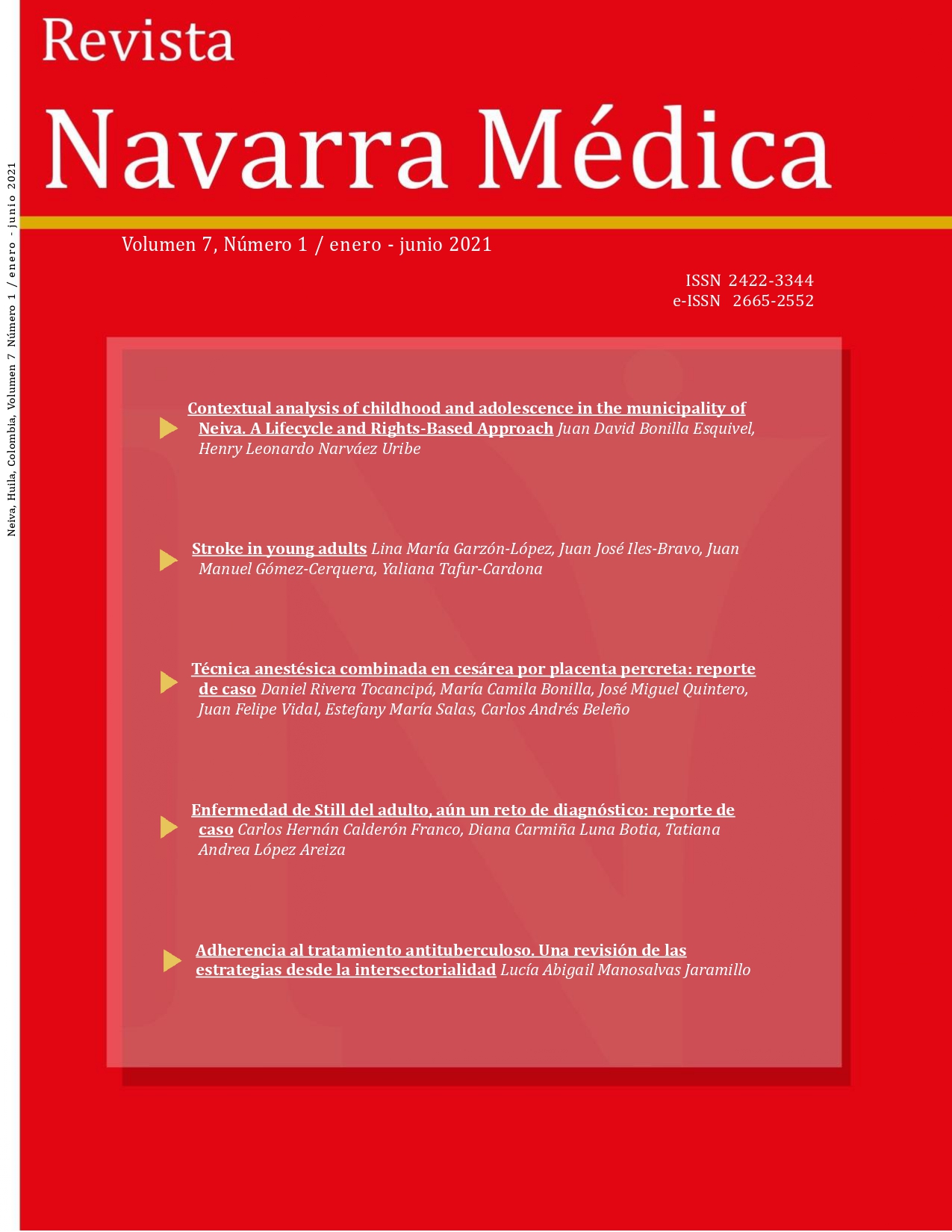Stroke in young adults
DOI:
https://doi.org/10.61182/rnavmed.v7n1a2Keywords:
Stroke, Etiology, Young Adult, Risk FactorsAbstract
Background Stroke is the second leading cause of mortality and disability in the world. It is les prevalent in people under 50 years of age but has an important impact on society and the healthcare system. The Trial of Org in Acute Stroke Treatment (TOAST) etiological classification system includes 5 categories: atherothrombotic, cardioembolic, lacunar, rarely occurring (unusual), and of undetermined origin. The etiological range of ischemic stroke in patients under 50 years of age is more heterogeneous than in older patients.
Objective To establish the most frequent etiology of ischemic stroke in patients under 50 years of age in Mediláser S.A. clinics of Tunja and Neiva in the years 2013 to 2017.
Methodology A descriptive, observational, retrospective, cross-sectional, retrospective study. The clinical history of patients under 50 years of age with a diagnosis of ischemic stroke confirmed by neuroimaging (Computed Tomography – CT or Magnetic Resonance Imaging - MRI) in the aforementioned clinics between 2013 and 2017 was reviewed. The etiology of ischemic stroke was determined according to the TOAST classification.
Results 69 patients were identified. The mean age was 39 years (SD: 2). Male/female ratio of 1.3/0.7. Regarding etiology, 22% were associated with cardioembolic origin, 7% atherothrombotic, 4% small vessel, 6% unusual, and 30 % undetermined. The mortality rate was 13% overall. In 70 % of the cases, the cerebral area most affected was the middle cerebral artery. Arterial hypertension was the risk factor most frequently associated with stroke, present in 38% of cases.
Conclusions The incidence of ischemic stroke increases significantly after the age of 40 years. Arterial hypertension also represents an important risk factor for experiencing a stroke before the age of 50 years.
References
Organización Mundial de la Salud (OMS) 10 principales causas de defunción en el mundo [Internet]. OMS. Available from: https://www.who.int/es/news-room/fact-sheets/detail/the-top-10-causes-of-death.
Ekker MS, M Boot E, B Singhal A, Sin Tan K, Debette S, Tuladhar AM, et al. Epidemiology, aetiology, and management of ischaemic stroke in young adults. Lancet Neurol. 2018; 17(9): 790–801. https://doi.org/10.1016/s1474-4422(18)30233-3
Hathidara MY, Saini V, Malik AM. Stroke in the Young: a Global Update. Curr Neurol Neurosci Rep. 2019;19(11):91. https://doi.org/10.1007/s11910-019-1004-1
Bonardo P, León Cejas L, mazziotti J, Zinnerman A, Fernández Pardal M, Martínez A, et al. AISYF: first national, prospective, multicenter study of young patients with stroke in Argentina. Medicina (B Aires). 2021;81(4):588-596. https://pubmed.ncbi.nlm.nih.gov/34453801/
O’Donnell MJ, Chin SL, Rangarajan S, Xavier D, Liu L, Zhang H, et al. Global and regional effects of potentially modifiable risk factors associated with acute stroke in 32 countries (INTERSTROKE): a case-control study. Lancet. 2016;388(10046):761-75. https://doi.org/10.1016/s0140-6736(16)30506-2
Maaijwee NAM, M., Rutten-Jacobs LCA, Schaapsmeerders P, van Dijk EJ, de Leeuw, FE. Ischaemic Stroke in Young Adults: Risk Factors and Long-Term Consequences. Nat Rev Neurol. 2014;10(6):315-25. https://doi.org/10.1038/nrneurol.2014.72
Renna R, Pilato F, Profice P, Della Marca G, Broccolini, A, Morosetti, R. Risk Factor and Etiology Analysis of Ischemic Stroke in Young Adult Patients. J Stroke Cerebrovasc Dis. 2013; (23):1-7. https://doi.org/10.1016/j.jstrokecerebrovasdis.2013.10.008
Koton S, Telman G, Kimiagar I, Tanne D, NASIS Investigators. Gender differences in characteristics, management and outcome at discharge and three months after stroke in a national acute stroke registry. Int J Cardiol. 2013; (168):4081–4. https://doi.org/10.1016/j.ijcard.2013.07.019
Van Alebeek ME, Arntz RM, Ekker MS, Synhaeve NE, Maaijwee NAMM, Schoonderwaldt H, et al. Risk factors and mechanisms of stroke in young adults: The FUTURE study. J Cereb Blood Flow Metab. 2018; 38(9): 1631–1641. https://dx.doi.org/10.1177%2F0271678X17707138
AdamsJr HP, Bendixen BH, Kappelle LJ, Biller J, Love BB, Gordon DL, Marsh EE. Classification of subtype of acute ischemic stroke. Definitions for use in a multicenter clinical trial. TOAST. Trial of Org 10172 in Acute Stroke Treatment. Stroke. 1993;24(1):35-41. https://doi.org/10.1161/01.str.24.1.35
Ioannidis SG, Mitsias PD. Patent Foramen Ovale in Cryptogenic Ischemic Stroke: Direct Cause, Risk Factor, or Incidental Finding? Front Neurol. 2020; (11):567. https://doi.org/10.3389/fneur.2020.00567
Yali Wang, Yue Dai, Jia Zheng, Yanxia Xie, Rongrong Guo, Xiaofan Guo, et al. Sex difference in the incidence of stroke and its corresponding influence factors: results from a follow-up 8.4 years of rural China hypertensive prospective cohort study. Lipids Health Dis. 2019; (18):72. https://doi.org/10.1186/s12944-019-1010-y
Wenzhi Wang, Bin Jiang, Haixin Sun, Xiaojuan Ru, Dongling Sun, Linhong Wang, et al. Prevalence, Incidence, and Mortality of Stroke in China. Circulation. 2017;(135):759–771. https://doi.org/10.1161/CIRCULATIONAHA.116.
Patel U K, Dave M, Lekshminarayanan A, et al. (April 24, 2021) Risk Factors and Incidence of Acute Ischemic Stroke: A Comparative Study Between Young Adults and Older Adults. Cureus 13(4): e14670. https://doi.org/10.7759/cureus.14670
N Yesilot Barlas, J Putaala, U Waje-Andreassen, S Vassilopoulou, K Nardi, C Odier, et al. Etiology of firstever ischaemic stroke in European young adults: the 15 cities young stroke study. Eur J Neurol. 2013; (20):1431–9. https://doi.org/10.1111/ene.12228
Perera KS, Swaminathan B, Veltkamp R, Arauz A, Ameriso S, Marti-Fabregas J, et al. Frequency and features of embolic stroke of undetermined source in young adults. Eur Stroke J. 2018;3(2):110-116. https://doi.org/10.1177%2F2396987318755585
Melkumova E, Thaler DE. Cryptogenic Stroke and Patent Foramen Ovale Risk Assessment. Interv Cardiol Clin. 2017; 6(4):487-493. https://doi.org/10.1016/j.iccl.2017.05.005
Schneider S, Kornejeva A, Vibo R, Kõrv J. Risk Factors and Etiology of Young Ischemic Stroke Patients in Estonia. Stroke Res Treat. 2017;2017:8075697. https://doi.org/10.1155/2017/8075697
Turin TC, Okamura T, Afzal AR, Rumana N, Watanabe M, Higashiyama A, et al. Hypertension and lifetime risk of stroke. J Hypertens. 2016; (34): 116–122. https://doi.org/10.1097/hjh.0000000000000753
Lira MT, Kunstmann S, Icaza G, Nuñez L, Escobar MC, Gainza D, et al. PM327 Attributable Risk of Coronary and Cerebrovascular Disease Risk Factors: 5 year follow-up of 9,700 subjects in Chile (FONIS SA09I222). Global Heart. 2014; 9(1):128-129. https://doi.org/10.1016/j.gheart.2014.03.1684
Sung S‐F, Lai EC‐C, Wu DP, Hsieh C‐Y. Previously undiagnosed risk factors and medication nonadherence are prevalent in young adults with first‐ever stroke. Pharmacoepidemiol Drug Saf. 2017;26(12):1458-1464. https://doi.org/10.1002/pds.4250
Downloads
Published
Issue
Section
License
Copyright (c) 2021 Lina María Garzón López, Juan José Iles Bravo, Juan Manuel Gómez-Cerquera, Yaliana Tafur-Cardona

This work is licensed under a Creative Commons Attribution-NonCommercial 4.0 International License.








